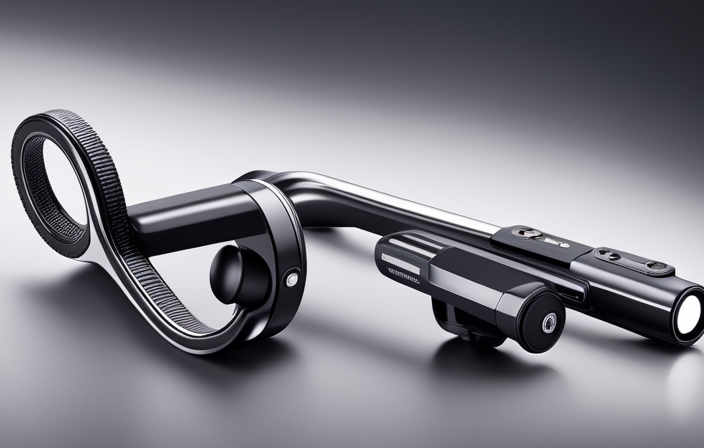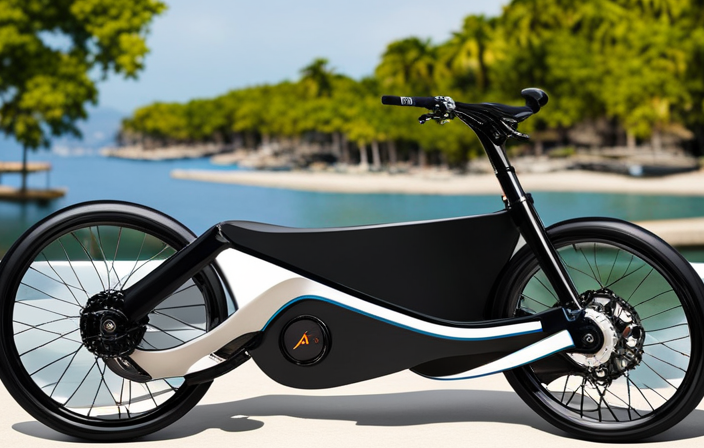I’ve always been fascinated by the intricate parts that make up an electric bike. One component that often goes unnoticed, but plays a crucial role, is the headset.
It’s the connection between the frame and the fork, allowing for smooth steering and control.
In this article, we’ll dive deep into the world of headsets on electric bikes, exploring their function, components, types, and the importance of choosing the right one.
So, let’s embark on this journey to discover the hidden power of the humble headset.
Key Takeaways
- The headset on an electric bike connects the fork and frame, enabling smooth steering and control.
- It acts as an interface between the fork and stem, maintaining overall stability and maneuverability.
- The top cap provides a clean finish to the handlebars, while the stem attaches the handlebars to the fork steerer tube.
- Choosing the right headset is important for compatibility with the fork and handlebars, ensuring a seamless and secure fit for a safe ride.
Understanding the Function of a Headset
To understand the function of a headset on an electric bike, you need to know that it connects the fork and frame, allowing for smooth steering and control. The headset acts as the interface between the fork and the stem, ensuring compatibility with the stem and providing a stable connection.
It plays a crucial role in maintaining the overall stability and maneuverability of the bike. When it comes to headset installation steps, it is essential to follow the manufacturer’s instructions carefully. This includes properly greasing the bearings, tightening the headset cap, and adjusting the preload to ensure a tight fit.
Understanding these steps is vital for a successful installation and optimal performance of the headset. With this understanding, let’s now explore the components of a headset and their functions.
The Components of a Headset
Take a look at the different parts that make up your bike’s headset. Understanding headset assembly is crucial for troubleshooting common headset issues.
Here are the components that come together to create a smooth and functional headset:
-
Top Cap: This small, often decorative piece sits on top of the stem and provides a clean finish to your bike’s handlebars.
-
Stem: The stem attaches the handlebars to the fork steerer tube, allowing you to steer the bike.
-
Bearings: These small, ball-shaped components facilitate smooth rotation between the fork steerer tube and the head tube.
-
Headset Spacers: These cylindrical pieces are used to adjust the height of the stem and handlebars for optimal comfort.
By understanding these parts, you can better troubleshoot common headset issues and ensure a safe and enjoyable riding experience.
Now, let’s dive into the different types of headsets and their unique features.
Types of Headsets
Check out the various types of headsets available to you in order to find the one that best suits your needs and preferences.
When it comes to headset materials, there are two main options: threaded and threadless.
Threaded headsets have been around for a long time and are made up of a threaded steerer tube and a threaded headset base. They are known for their simplicity and ease of maintenance.
However, threadless headsets have gained popularity in recent years due to their advantages. Made up of a stem that clamps onto a smooth steerer tube, threadless headsets offer improved stiffness, durability, and adjustability. They also allow for easier installation and removal of the fork.
Now that you know about the different types of headsets, let’s dive into how to choose the right one for your electric bike without any further delay.
How to Choose the Right Headset for Your Electric Bike
When it comes to choosing the right headset for your electric bike, two key factors to consider are compatibility with your bike’s fork and handlebars, as well as the overall quality and durability of the headset.
Ensuring that the headset is compatible with your bike’s specific fork and handlebar setup is crucial for a seamless and secure fit.
Additionally, investing in a high-quality and durable headset will not only enhance your riding experience, but also provide long-lasting performance and reliability.
Compatibility with Fork and Handlebars
Make sure your headset is compatible with your fork and handlebars before installing it on your electric bike. This is crucial to ensure a smooth and safe ride.
When it comes to fork compatibility, you need to consider the type of fork your bike has. There are different types such as straight, tapered, and integrated. Your headset should match the specific type of fork you have.
Handlebar compatibility is equally important. The diameter of your handlebars should match the diameter of the stem on your headset. If they don’t match, you may need to purchase a new stem or handlebars.
It’s important to check these compatibility factors before installation to avoid any issues or potential damage to your bike.
Now, let’s move on to the next section about the quality and durability of headsets.
Quality and Durability
Now, let’s talk about the reliability and long-lasting nature of headsets. A high-quality headset is essential for a smooth and enjoyable riding experience on your electric bike. The material options for headsets vary, including steel, aluminum, and carbon fiber. Each material has its pros and cons, but it’s crucial to choose one that suits your riding style and preferences.
Here are some key points to consider:
-
Material strength: Opt for a headset made from durable materials like aluminum or carbon fiber to ensure longevity and withstand the rigors of riding.
-
Sealed bearings: Look for headsets with sealed bearings, as they provide better protection against dirt, moisture, and debris, leading to improved performance and longevity.
-
Precision engineering: A well-designed headset ensures smooth steering and precise control, enhancing your overall riding experience.
-
Reduced vibration: A high-quality headset minimizes vibrations, resulting in a more comfortable and stable ride.
The quality and durability of your headset directly impact your riding experience.
Now, let’s move on to the next section, where we’ll discuss installing and maintaining your headset for optimal performance.
Installing and Maintaining Your Headset
To properly install and maintain your headset on an electric bike, you’ll need to ensure it is securely tightened and regularly checked for any signs of wear and tear. A well-maintained headset not only ensures smooth steering but also enhances the overall riding experience. Let’s take a look at some troubleshooting common issues and proper cleaning techniques to keep your headset in top shape.
| Common Issues | Troubleshooting |
|---|---|
| Loose headset | Tighten the stem bolts and adjust the headset cap |
| Rough steering | Clean and lubricate the bearings |
| Clicking or creaking | Inspect and replace worn bearings |
Proper cleaning techniques involve removing the stem and cleaning the bearings with a gentle degreaser. Once cleaned, apply a high-quality lubricant to ensure smooth operation. Neglecting headset maintenance can lead to various issues, including premature wear and safety hazards. In the next section, we’ll discuss the signs of a damaged or worn-out headset, which will help you identify when it’s time for a replacement.
Signs of a Damaged or Worn-out Headset
Now that we have learned how to install and maintain our headset, it is important to be able to recognize the signs of a damaged or worn-out headset.
As an avid electric bike rider, I have experienced firsthand the frustration of a malfunctioning headset. One common symptom is a noticeable clunking or clicking sound when turning the handlebars. This could indicate loose or worn-out headset bearings.
Another sign is difficulty in steering, where the handlebars feel stiff or unresponsive. In some cases, you may even feel excessive play or movement in the headset when you apply pressure.
If any of these issues arise, it is crucial to diagnose and address them promptly to ensure your safety and the integrity of your electric bike.
Upgrading Your Headset for Better Performance
When it comes to upgrading your electric bike’s headset, there are two key points to consider: lightweight and high-performance options, as well as integrated headsets for a streamlined look.
Lightweight and high-performance options can greatly enhance your riding experience by reducing the weight of your bike and improving its overall performance.
On the other hand, integrated headsets not only provide a sleek and seamless appearance, but they also contribute to the aerodynamics of your bike, allowing for a smoother and more efficient ride.
Lightweight and High-performance Options
Looking for a lightweight and high-performance option for your electric bike? Consider checking out the headset options available.
The headset is an essential component of your bike’s steering system, allowing for smooth and precise handling.
When it comes to choosing a headset, there are a few factors to consider. Firstly, the materials used in the construction of the headset can greatly impact its weight and performance. Carbon fiber and aluminum are popular choices for their durability and lightness.
Additionally, noise reduction techniques, such as sealed bearings and rubber seals, can help to minimize unwanted sounds while riding.
By investing in a high-quality headset with these features, you can enhance your riding experience and enjoy a more efficient and enjoyable ride.
Now, let’s delve into the world of integrated headsets for a streamlined look.
Integrated Headsets for Streamlined Look
If you want a sleek and modern appearance for your ride, consider opting for integrated headsets. These innovative components offer several advantages that can enhance your biking experience.
Here are some key benefits of integrated headsets:
- Streamlined look: Integrated headsets are designed to seamlessly blend into your bike’s frame, giving it a clean and polished appearance.
- Improved stability: The integration of the headset into the frame provides better stability and handling, allowing for more precise steering.
- Reduced weight: By eliminating the need for additional parts, integrated headsets contribute to a lighter overall bike weight, enhancing performance.
- Enhanced durability: The integrated design reduces the risk of loose or damaged headset components, resulting in a more durable and long-lasting setup.
However, it’s important to consider the potential disadvantages of integrated headsets:
- Limited adjustability: Integrated headsets may offer limited options for adjusting the handlebars to your preferred height and angle.
- Difficulty of maintenance: Due to their integrated nature, servicing or replacing integrated headsets may require specialized tools or professional assistance.
With these factors in mind, it’s essential to weigh the advantages against the disadvantages when choosing an integrated headset for your electric bike.
In the following section, we will explore common headset issues and provide troubleshooting tips to help you maintain optimal performance.
Common Headset Issues and Troubleshooting Tips
To troubleshoot common headset issues on your electric bike, start by checking for loose or worn-out bearings. The headset is an essential component of your bike’s steering system, and any problems with it can result in poor handling and potential safety hazards. Here are some troubleshooting tips for common issues:
| Common Issue | Possible Cause | Solution |
|---|---|---|
| Loose headset | Insufficient tightening of headset bolts | Tighten headset bolts |
| Noisy headset | Dry or worn-out bearings | Lubricate or replace bearings |
| Stiff steering | Improper headset adjustment | Adjust headset properly |
Importance of a Properly Functioning Headset for Safety
When it comes to riding an electric bike, two key factors that contribute to a safe and enjoyable experience are responsive steering and preventing fork failure.
Ensuring responsive steering is crucial for maintaining control and maneuverability, especially when navigating tight corners or avoiding obstacles.
On the other hand, preventing fork failure is essential to avoid accidents and injuries, as a malfunctioning fork can lead to loss of control and potential crashes.
In this discussion, we will delve into the importance of these two aspects and explore ways to ensure they are properly addressed for a safer and more enjoyable ride.
Ensuring Responsive Steering
Responsive steering is essential for a safe and enjoyable ride on an electric bike, so it’s important to ensure that the headset is properly adjusted.
The headset connects the fork to the frame, allowing the front wheel to turn smoothly. To maintain responsive steering, regular headset maintenance is necessary.
Start by checking for any signs of looseness or play in the headset. If there is any, it’s crucial to tighten it properly. Additionally, lubricating the headset bearings regularly will help reduce friction and ensure smooth steering.
By taking these steps, you can maintain the responsiveness of your electric bike’s steering and enhance your riding experience.
Now, let’s move on to preventing fork failure and ensuring the safety of your electric bike.
Preventing Fork Failure
Make sure you regularly inspect and maintain the fork on your bike to prevent any potential failure. As a passionate cyclist, I understand the importance of keeping your bike in top condition for a safe and enjoyable ride.
When it comes to preventing rust and choosing the right materials, here are a few things to keep in mind:
- Regularly clean and dry your fork to prevent rust from forming.
- Consider using a protective coating or lubricant to provide an extra layer of defense against corrosion.
- Opt for forks made from materials such as carbon fiber or stainless steel, which are known for their durability and resistance to rust.
- Invest in high-quality seals and bushings to ensure smooth operation and prevent moisture from entering the fork.
By taking these steps, you can prolong the lifespan of your fork and maintain optimal performance on your electric bike.
Now, let’s delve into the role of the headset in electric bike performance.
The Role of Headset in Electric Bike Performance
Understanding the role of the headset in your electric bike’s performance is crucial for a smooth and enjoyable ride. The headset is the component that connects the fork to the frame, allowing you to steer and control the bike.
It is important to ensure that the headset is compatible with your electric bike, as different models may require specific types of headsets. Regular maintenance is also vital for the longevity of your headset.
Over time, dirt and debris can accumulate, causing friction and affecting the smoothness of your ride. By cleaning and lubricating the headset regularly, you can ensure that it functions properly and lasts longer.
Taking care of your headset will not only improve your riding experience but also prevent potential issues in the future. Now let’s delve into some headset maintenance tips for longevity.
Headset Maintenance Tips for Longevity
As we delve into the world of electric bike maintenance, it is essential to address the proper care of the headset. Neglecting this crucial component can lead to decreased performance and potential safety hazards. To ensure the longevity of your headset, I will share some tried and tested cleaning techniques, as well as common mistakes to avoid.
To emphasize the importance of headset maintenance, take a look at this informative table:
| Cleaning Technique | Common Mistakes to Avoid |
|---|---|
| Regularly wipe down the headset with a clean cloth | Using harsh chemicals or abrasive materials |
| Lubricate the bearings with a suitable lubricant | Over-lubricating, which can attract dirt and grime |
| Check for any loose or worn parts | Overtightening or neglecting to tighten properly |
Headset Innovations and Trends in the Electric Bike Industry
Let’s take a look at some exciting innovations and trends in the electric bike industry that are shaping the future of cycling.
One of the key areas of focus is headset design. Headsets play a crucial role in maintaining stability and control while riding, and advancements in this technology have a significant impact on the overall ride quality.
Manufacturers are constantly pushing the boundaries to create lighter, stronger, and more efficient headset systems. We’re seeing trends like integrated headsets, where the bearings are housed directly into the frame, reducing weight and improving rigidity. Additionally, adjustable headsets are becoming more popular, allowing riders to fine-tune their bike’s geometry to suit their preferences.
These advancements in headset design are revolutionizing the electric bike industry and enhancing the riding experience for cyclists of all levels.
Now, let’s move on to the next section and explore a DIY headset replacement guide.
DIY Headset Replacement Guide
When it comes to replacing the headset on your electric bike, having the right tools and equipment is crucial. You’ll need a headset press tool, a set of headset wrenches, and some grease for lubrication.
In this step-by-step guide, I’ll walk you through the process of removing the old headset and installing the new one, ensuring a smooth and safe ride for your electric bike.
Tools and Equipment Needed
To properly install a headset on your electric bike, you’ll need a few tools and equipment. Bike maintenance is crucial for optimal performance and longevity. As an avid cyclist, I understand the importance of troubleshooting issues and finding solutions. Here are some essential tools and equipment you’ll need for a successful headset installation:
| Tools | Equipment |
|---|---|
| Allen wrench set | Headset press |
| Adjustable wrench | Grease |
| Torque wrench | Headset cups |
| Cable cutters | Crown race remover |
Having these tools readily available will make the installation process smooth and efficient. The Allen wrench set will help you loosen and tighten bolts, while the adjustable wrench is essential for adjusting the headset. A headset press is necessary for pressing the headset cups into place, and a torque wrench ensures proper tightening of bolts. Don’t forget to use grease to lubricate the components and prevent corrosion. Lastly, cable cutters help with any cable adjustments that may be needed during the installation. Now that you have the necessary tools, let’s move on to the step-by-step instructions for installing your headset.
Step-by-Step Instructions
First, make sure you have all the necessary tools and equipment for the headset installation process. A headset is a vital component of any electric bike, as it connects the fork to the frame and allows for smooth steering.
To install it, start by removing the old headset using a headset press and crown race remover. Once removed, clean the frame and fork thoroughly before installing the new headset. Grease the bearings and press them into the frame, making sure they are properly aligned.
Finally, tighten the headset cap and adjust the bearings for smooth operation. Troubleshooting common headset issues, such as loose or tight steering, can be done by adjusting the headset preload or checking for worn bearings.
With the headset properly installed, you can now enjoy a smooth and enjoyable ride.
Expert Recommendations for Headset Upgrades
If you want to improve your electric bike’s performance, you should definitely consider upgrading the headset, according to experts.
Upgrading headset bearings can greatly enhance the smoothness of your ride, reducing friction and increasing efficiency. Additionally, improving headset stability can provide better control and handling, giving you a safer and more enjoyable biking experience.
Here are four reasons why upgrading your electric bike’s headset is a worthwhile investment:
-
Reduced friction: Upgraded headset bearings are designed to minimize friction, resulting in a smoother ride and less energy wasted.
-
Increased durability: High-quality headset bearings can withstand heavy loads and frequent use, ensuring longevity and reliability.
-
Enhanced control: Upgrading your headset can improve steering precision, allowing for better maneuverability and control on different terrains.
-
Improved safety: A stable headset ensures that your electric bike responds predictably to your input, reducing the risk of accidents and promoting rider safety.
By upgrading your electric bike’s headset, you can optimize its performance and ride with confidence.
Now, let’s delve into the importance of a well-maintained headset for an electric bike.
Conclusion: The Importance of a Well-maintained Headset for an Electric Bike
When it comes to maintaining your electric bike, ensuring the stability and smoothness of your ride is crucial. One important aspect of maintenance that often gets overlooked is the headset.
The headset is the component that connects the fork to the frame, allowing you to steer your bike. By regularly maintaining your headset, you can greatly improve your overall riding experience.
To keep your headset in top condition, there are a few maintenance techniques you should follow.
Firstly, make sure to clean and lubricate the bearings regularly to prevent any unnecessary friction.
Secondly, check for any signs of wear or damage, such as loose or wobbly steering, and replace any worn-out parts promptly.
Frequently Asked Questions
Can I use a regular headset on my electric bike?
Yes, you can use a regular headset on your electric bike, but it is recommended to use an electric bike headset for better compatibility. Using an electric bike headset offers benefits like improved stability, smoother handling, and enhanced control for an exhilarating riding experience.
How often should I replace my headset?
As an avid electric bike rider, I know that the lifespan of a headset can vary depending on usage and maintenance. Generally, it’s a good idea to replace your headset every 2-3 years or when you notice signs of wear such as loosening, wobbling, or grinding sounds.
Are there any specific maintenance steps I need to take for an electric bike headset?
To properly maintain an electric bike headset, there are a few specific steps you should take. Regularly check for loose or worn bearings, clean and lubricate the headset, and ensure proper adjustment for smooth and safe riding. Common issues include loose or rattling headsets.
Can I upgrade my headset to improve the performance of my electric bike?
Yes, you can upgrade your electric bike’s headset to significantly improve its performance. By investing in a high-quality headset, you’ll experience improved stability, control, and overall ride quality, enhancing your electric bike riding experience.
What are some innovative trends in headset technology in the electric bike industry?
Wireless communication and noise cancellation are two innovative trends in headset technology for electric bikes. How cool would it be to have crystal clear audio while riding? These advancements enhance the overall biking experience.
Conclusion
In conclusion, having a well-maintained headset is crucial for the optimal performance of your electric bike.
It acts as the backbone, providing stability and control while riding.
Just like a well-tuned instrument, a properly functioning headset allows you to navigate through the streets with ease, as if you were dancing on the pedals.
So, don’t overlook the importance of this often overlooked component.
Take the time to choose the right headset, install it correctly, and give it the care it deserves.
Your electric bike will thank you with a smooth and exhilarating ride.









